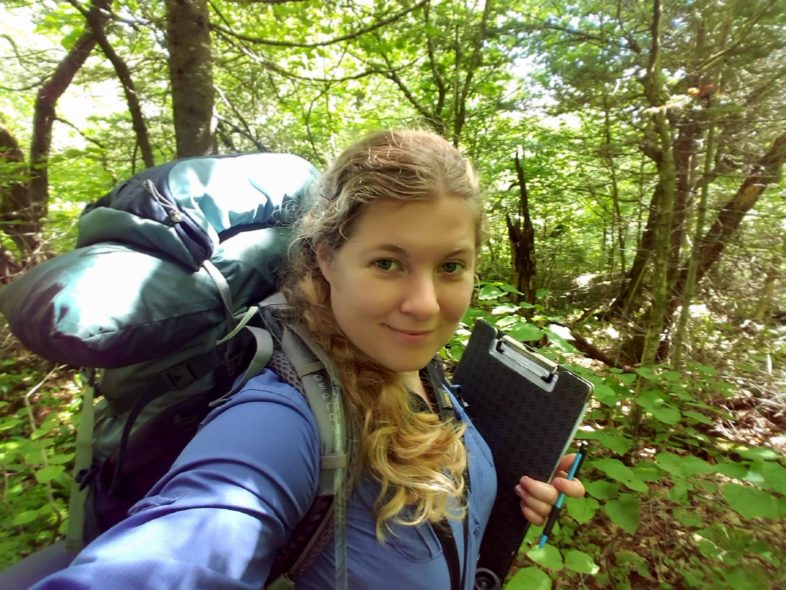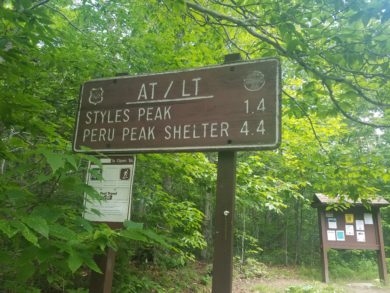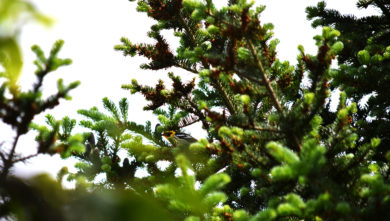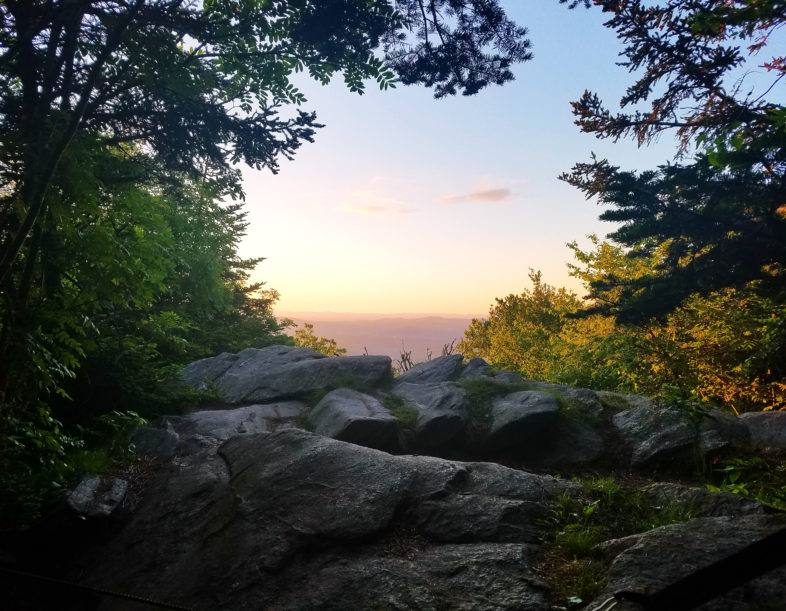By Troi Perkins
Styles Peak is a little-known mountain that is dwarfed by its more popular neighbor, Peru Peak. Yet hiking this survey route was quite pleasant and awarded me with its own unique experiences that make it just as worthy. The hike itself was challenging and, while the reward may not have been an 180 degree view, there is a vista that comes with many other little surprises along the way.
At first the path’s incline is barely noticeable, just a few out of placed breaths as the backpack weight starts to settle in. Then comes the longer strides it takes to go up the rock steps with a few white blazes passing by to help tell the time. Before I could think much of being out of breath, a tree trunk along the trail sports a furry little resident wishing me good luck; or at least a hurry up and move along chirp. As the incline gets steeper and that forest starts to change from hardwoods into mixed spruce and fir, the sounds start to change too. Teacher-teacher-teacher rings out from an Ovenbird while a Red-eyed Vireo sings its never-ending song in the background. As they fade a familiar zoo-zee, zoo-zoo-zee is carried in by a light breeze. The canopy seems to be alive even in the middle of the day with Black-throated Green Warblers and Yellow-rumped Warblers zipping from tree to tree with Dark-eyed Juncos eagerly joining the mix.
Once the forest becomes dominant with Balsam Fir and Red Spruce, a sign I’m approaching my first survey point, the sounds again change. White-throated Sparrows sing from atop the branches with their song of old-sam-peabody-peabody while Swainson’s Thrush make their presence known with their flute-like upward spiraling songs. However, if you are looking among the thickets of spruce and fir, you might just catch a glimpse of one particularly brilliant bird, the Blackburnian Warbler. His “fire throat” for me was a little duller in the clouded light but his colors were nonetheless commanding my attention as he sat on his perch right at the location of survey point number two.
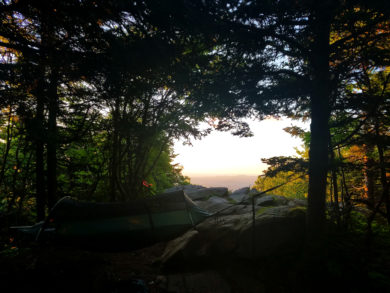 Onwards I go and the rocks turn to small boulders while the trail narrows. There’s an abrupt clearing to the right that marks my third survey point; a rock ledge with a majestic view of the green mountains. It was here I decided to spend the night as Black-throated Green Warblers went about foraging and collecting nesting material in the brush. My hammock swayed me to sleep as the wind swept over the mountain top bringing with it the promise of a beautiful morning.
Onwards I go and the rocks turn to small boulders while the trail narrows. There’s an abrupt clearing to the right that marks my third survey point; a rock ledge with a majestic view of the green mountains. It was here I decided to spend the night as Black-throated Green Warblers went about foraging and collecting nesting material in the brush. My hammock swayed me to sleep as the wind swept over the mountain top bringing with it the promise of a beautiful morning.
I reached my first point by 4:00am knowing I’d have to wait till 45 minutes before sunrise per MBW protocol. Like clockwork, at 4:24am, the morning sun is welcomed onwards by the chorus of forest birds. I heard Winter Wrens, Black-throated Blue and Green Warblers, even Hermit Thrush and Swainson’s Thrush seemed to be dueling it out for my attention. The first 20 minute period came to a close with a family of Dark-eyed Juncos zipping around my head as Blue Jays called off in the distance. Further up my route Blackpoll Warbler’s were also letting their presence be known with songs reminiscent of rattlesnake warnings. A couple of Yellow-bellied Flycatchers called back and forth as crows started to leave their nightly roosts. At the end of my survey route, amongst a thicket filled with snags, a flicker of red signaling a Pileated Woodpecker could be seen going from tree to tree, the woodpecker itself uttering a few Wuk, Wuks and drumming out it’s breakfast.
With my survey route completed, I headed back to watch the rest of the mist curve through the mountain valleys and disappear into the sky. This route, which was left unclaimed by a volunteer citizen scientist this year, perhaps in favor of other famous overlooks, proved faithful in all its beauty and awarded me with an amazing array of little surprises along the way. From my first Blackburnian Warbler sighting to a misty mountain sunrise, I believe Styles Peak is a little gem of its own worthy of any volunteer’s effort in coming years.
